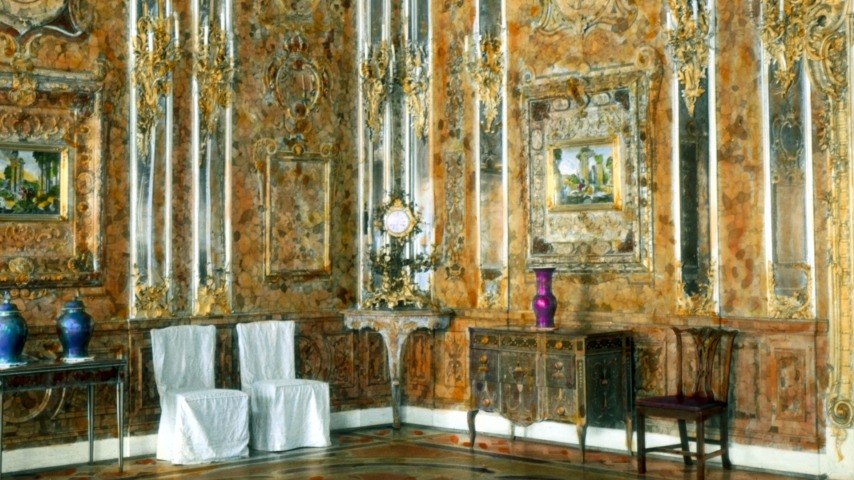Strangest fact: If the Nazis did in fact steal the room, it wasn’t the first time it had been moved. It was planned for Charlottenburg Palace in Berlin in 1701, but by the time construction began, the project had moved across town to Berlin City Palace. The second king of Prussia, Frederick William I (who, for reasons that are unclear, used that name in between his father, Frederick I, and his son, Frederick II) gave the entire room to Russian Tsar Peter The Great, to seal an important alliance. The entire room was disassembled and transported to St. Petersburg, where it was rebuilt in the Catherine Palace, where it remained until WWII. Peter then expanded and renovated the room until it covered 590 square feet and contained over 13,000 pounds of amber.
When the Nazi invasion of the USSR began, Russian curators attempted to disassemble the room and found the amber was too dry and brittle, and would crumble if a move was attempted. But the Germans were able to disassemble the room within 36 hours and move it to Köningsberg Castle; Wikipedia gives no hint as to how or why the Germans succeeded where the Russians could not.
Thing we were happiest to learn: Brezhnev also ordered the Amber Room rebuilt. In 1979, he commissioned a replica, based on drawings and black-and-white photos of the original. It was to be built at Tsarskoye Selo, a former imperial palace near St. Petersburg, enlisting 40 Russian and German amber artisans. Despite financial difficulties and the collapse of the USSR, the project was completed in 2003, just in time for St. Petersburg’s 300th anniversary.
Thing we were unhappiest to learn: Every attempt to locate even fragments from the Amber Room has failed. After the war, Italian stone mosaics were found in the ruins of Köningsberg Castle, but no amber. The public was denied access to the ruins, fueling rumors that the authorities were hiding the Amber Room there, but there’s no evidence that was the case. Polish divers in 2020 even explored the wreck of the S.S. Karlsruhe, a ship that was sunk while evacuating German troops from Prussia late in the war, in the face of the advancing Soviet army. It contained crates rumored to hold pieces of the room; it turned out they held personal belongings for the evacuees.
Best link to elsewhere on Wikipedia: Apart from his involvement with the Amber Room and his odd naming convention, Frederick William I was a fascinating figure in his own right. He built the newly-formed kingdom into a regional power, reigning in the corruption of his father’s court, and doubling the size of the army. But he was also a harsh ruler, particularly to his son, Frederick II. Nicknamed “Fritz” (which we’ll call him here for clarity), his father wanted him to be a soldier, awakening him with cannon fire every morning at age six, and giving him a regiment of children his age to put through drills.
But Fritz was cultured and intellectual—and, to his father’s horror, gay. When Fritz embarked on a teenage affair with a page at court, Frederick William had the page sent to the border as a soldier, while Fritz was sent to live at the royal hunting lodge, which was more in line with FW’s idea of a suitably masculine pursuit. Fritz attempted to flee to England with his tutor (who he may have also been romantically involved with), and FW had the tutor beheaded in front of his son. He demanded the young prince be court-martialed; the court in question refused, declaring a member of the royal family to be above their jurisdiction.
Holy Roman Emperor Charles VI called his own trial, and Fritz was imprisoned for two months. A few years later FW forced his son to marry a princess who he despised, but their father-son relationship did improve somewhat until, by the time of Frederick William’s death, the two were, “on at least reasonable terms,” which is what in the business is known as damning with faint praise. As king, Frederick II became a patron of the arts and the Enlightenment, but was also a successful military leader, who was beloved enough by Prussians that he’s still remembered as Frederick the Great.
Further down the Wormhole: While the room was, as the name suggests, largely decorated with amber, the design was augmented with gold leaf. Gold, has of course been valued since time immemorial for its rarity and beauty, and the ideal of a city so prosperous its streets are paved with this stuff is an idea as old as the Bible. Revelation 21:21 describes the city of New Jerusalem thusly, and various Christian sects have used the name for present and future settlements. One such was an 18th-century utopian community founded by a nonbinary Quaker evangelist known as Public Universal Friend. We’ll hear the good word from them next month.


 Keep scrolling for more great stories from The A.V. Club.
Keep scrolling for more great stories from The A.V. Club.